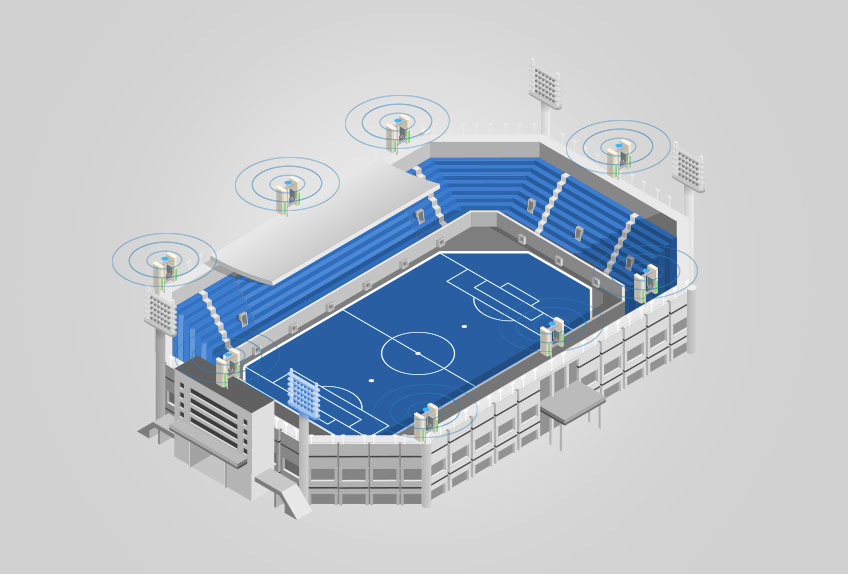Distributed Antenna Systems are an integral part of any high-functioning organization in ensuring uninterrupted wireless coverage for its effective functioning (Read more). Apart from the evident functional benefit, DAS (Distributed Antenna Systems) also have a direct implication on the organization’s revenue and overall customer experience. The beauty of DAS is that it works for any business that is looking to improve cellular coverage or adding additional cellular capacity irrespective of its size.
Know more about why your office needs DAS (Read More).
While talking about DAS people commonly talk about Active DAS or Passive DAS however there is a third kind, Hybrid DAS that is now being widely recommended by DAS partners.
Defining Passive, Active, and Hybrid DAS
Passive DAS: Capture cellular signals from outside cell towers through the use of an antenna. This signal is then amplified up to 32 times with the help of an amplifier unit. The amplified signals are redistributed through antennas and coaxial cables inside the facility.
Active DAS: Creates cellular signals from a centralized source using fiber optic cables to distribute the signals to remote nodes placed across the facility.
Hybrid DAS: This is a combination of Passive and Active design DAS. Hybrid DAS relies on a hybrid system of using coax and fiber optics to distribute signals.
Difference between Passive, Active, and Hybrid DAS
Passive DAS
Passive DAS essentially relies on outside cellular signals to amplify and distribute using passive components like coaxial cables, bi-directional amplifiers, splitters, and diplexers. This is the simplest form of DAS design and is typically used indoors and in smaller areas. They are also easy to install and hence in terms of cost they turn out to be the least expensive option.
Due to its reliance on outside signals from cell towers, they are carrier agnostic and can support multiple carriers within the same facility. Since Passive DAS redistributed the network’s macro signals they have lesser hassles of carrier approvals and coordination, which means they can be installed without any pre-approvals from network carriers.
Passive DAS works best used for indoor facilities where coverage and network amplification is the main aim. Passive DAS solutions are also applied in buildings with “dead zones” due to concrete and other building materials that block the RF signals from penetrating.
There are however some limitations in terms of the reach of Passive DAS and due to the use of coaxial cables suffer from signal loss. With Passive DAS adding capacity is not an option.
Active DAS
Active DAS is an infrastructure and investment-intensive connectivity solution. Active DAS is applied in extremely large areas typically like a football stadium, massive exhibitions, or an airport. Active DAS systems can be designed to support any size of the facility and up to any capacity.
Active DAS is used where adding capacity and ensuring wall-to-wall connectivity are the major criteria. Active DAS is therefore not cheap, in fact, requires huge capital investment to implement. The cost of implementing Active DAS may run from a few hundred thousand dollars to a few million dollars depending on the size and the nature of the implementation.
Active DAS uses advanced fiber-optic technologies for the transportation of RF signals at incredible efficiency. Thus an Active DAS solution works both for enhancing coverage as well as building additional capacity.
Active DAS is set up with a single carrier network and hence is not carrier agnostic. Additional carriers can be added with additional investments. Active DAS requires pre-approvals and a lot of coordination with network carriers and with different regulations that add to the time required for deployment. Active DAS solution has great benefits but its application is not common. Given its complex nature, Active DAS is applied in extremely large spaces with big budgets to justify the investment and the time taken for its deployment.
Hybrid DAS
Hybrid DAS is a combination that brings the best of both Active and Passive DAS for a more wholesome solution. The usability and effectiveness of Hybrid DAS is the reason why this solution is being increasingly applied when it comes to improving cellular network coverage.
Hybrid DAS uses fiber optics to transport signals which are further distributed using passive antenna systems. The use of fiber optics ensures that the signal loss is lesser compared to Passive DAS. However, the coax cables used to connect the antennas do contribute to some amount of signal loss.
Hybrid DAS is a scalable model that can be modified to work with more than one network carrier. They work best for medium-sized facilities considering the investments and time for deployment required are much lower than Active DAS.
The best DAS solution for your requirement
The final implementation of the DAS solution requires a proper consideration of the factors mentioned above. Moreover, it requires a proper technical audit, site survey, and collaboration between the facility and DAS partner to draw a solution with the best fit.
We here At Kaytech Coverage provide world-class connectivity solutions and ensure your solution works for you. We have a team of expert connectivity engineers to design efficient and cost-effective DAS solutions and provide post-support maintenance. Write to us by visiting https://ktcoverage.com/contact for a free consultation and audit.


